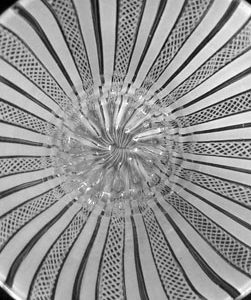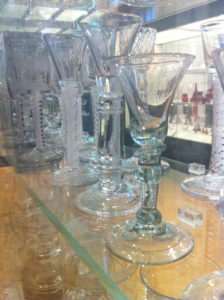In a series of blog posts, postgraduate intern Victoria Druce (MSc student at Imperial College London) looked behind the scenes to give an insight into how she researched the filigree glasses.
It was an early start at the Courtauld Gallery for the installation of the new Illuminating Objects display on the 24th July, collecting together the mount maker, case designer, label designer, curator and intern (that’s me) to put on display the third instalment of this year’s Illuminating Object series.
Over the past few weeks, having collected together my research and decided on an angle for the display, I have been writing the labels and web text for the projects. Both the texts were a real challenge – the word count for the labels is tiny at just 150 words each! Condensing my research into such a small space whilst keeping it engaging and interesting is a real skill and much of it had to hit the cutting room floor. My first attempts were twice the maximum limit and it took a lot of clever editing to shrink them down to size. The web text is a little longer and will hopefully give any curious visitors to the gallery or the website a bit of extra detail about the background of the glasses which are on display this summer.
Along with the finished labels, the mount and blocks for the display case were collected together this morning for the installation. It was the first time we’d seen the glasses in their case but after a little tweaking of spacing, the glasses looked great in their case. The lighting gives both the glasses a beautiful glow which lights up their exquisite detail. The goblet sits on a block to stand above the wine glass and together they make a maximum impact as visitors walk into Room 4 of the gallery.
After weeks of research, a meeting, talking with experts, experiments, writing, re-writing and final touches this Illuminating Objects project is drawing to a close. Many thanks go to Suzanne Higgott at the Wallace Collection for her expert help throughout the project and to Collin Brain for his insight into the science of lead glass. Also thanks to the gallery’s chief conservator Graeme Barraclough and to Kate Edmonson. Finally, thanks to Sacha Gerstein for her help and advice during the project.




